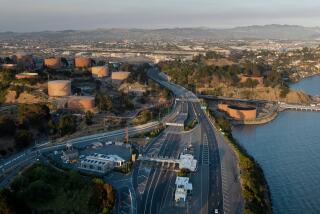Chevron to Cut 800 Jobs, Sell Some Oil, Gas Assets
- Share via
Chevron Corp., the oil industry’s sluggish giant, announced a sweeping restructuring of its U.S. oil and gas division Tuesday that will cut 800 to 1,000 jobs and sell off $700 million in assets as part of a long-term strategy to bolster financial performance.
The moves will cost Chevron $25 million to $30 million in charges in the first quarter of 1990, primarily for employees’ severance packages, but will eventually save the company $140 million to $160 million a year in salaries and operating costs, Chevron spokesman Michael W. Libbey said from the company’s San Francisco headquarters.
Analysts generally applauded the planned restructuring by the nation’s third-largest energy company, whose financial performance has trailed that of its major competitors due in part to high costs, low efficiencies and top-heavy staff.
“Clearly, management now sees that they need to restructure and that there’s tremendous potential value to be unlocked,” said Frederick P. Leuffer, an industry analyst with C. J. Lawrence, Morgan Grenfell Inc. in New York and one of Chevron’s tougher critics.
Chevron’s restructuring of its U.S. exploration and production operation is part of a longstanding industry trend to streamline such operations and focus more attention overseas. Unocal Corp., Occidental Petroleum Corp., Mobil Oil Corp. and British Petroleum have already undertaken similar downsizing.
Chevron’s moves may signal disenchantment with domestic oil prospects in light of its frustration in trying to produce oil off the coast of Santa Barbara County through the Point Arguello project, analysts said.
Chevron, the lead partner in a consortium of 18 oil companies, took a $445-million charge in the fourth quarter of 1989 on its share of a total $2-billion investment in the project, which sits idle as county officials debate how to transport the project’s oil. Partly as a result of the charge, Chevron’s 1989 earnings plummeted to $251 million from nearly $1.8 billion in 1988.
It is also unlikely that Chevron will be allowed to drill any time soon in the Arctic National Wildlife Refuge, where it has a large interest, because of heightened environmental concerns in the wake of the Exxon Valdez and Orange County oil tanker spills.
After Tuesday’s announcement, Chevron’s stock fell 62.5 cents a share to $69.25 on the New York Stock Exchange.
The restructuring, which grew out of a study completed this month, is part of a continuing effort to improve Chevron’s stock price and its return to shareholders. Some details:
* Between 800 and 1,000 jobs will be cut this year, half through sale of assets. That includes middle and senior management jobs, as well as all 450 positions at Chevron’s exploration and production offices in San Ramon, Calif. In subsequent years, more jobs will be cut through attrition, early retirements and other programs.
* Chevron will accelerate its sales of less-profitable oil and gas properties in the United States, auctioning off more than $700 million worth of properties in the next two years, or about 1,000 of Chevron’s 1,700 fields. The fields, many acquired in the Gulf Oil merger in 1984, represent only about 11% of Chevron’s total daily production of oil and gas, Libbey said. Chevron sold about $210 million in assets in 1988 and 1989.
* The company will eliminate several layers of management, phase out three regional offices in San Ramon, Houston and New Orleans and consolidate operations under seven business units accountable for their own profits and losses directly to company headquarters. Also, production operations now managed in Ventura will be moved to Bakersfield.
The move should cut Chevron’s high cost of producing oil. In 1989, it spent about $6.40 to find and produce a barrel of oil, more than any of its major competitors. The restructuring, scheduled to be completed by Oct. 1, will help Chevron achieve its goal in the next three to five years of cutting that cost to $5.25 per barrel in 1990 dollars, comparable to the costs of its competitors, said Leonard Porter, Chevron’s Western regional general manager for production.
Chevron’s Chairman Kenneth T. Derr is scheduled to discuss details of the restructuring in meetings with financial analysts in New York today.
Chevron produced about 2.6 million barrels of oil and gas a day in 1989, equally divided between U.S. and foreign production.
The restructuring does not appear to be a reaction to Pennzoil Co.’s acquisition of an 8.8% stake in Chevron last year. Since that purchase, Chevron has sued Pennzoil and strengthened its defenses against a possible takeover.
More to Read
Inside the business of entertainment
The Wide Shot brings you news, analysis and insights on everything from streaming wars to production — and what it all means for the future.
You may occasionally receive promotional content from the Los Angeles Times.










